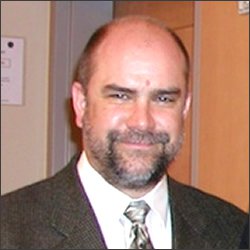Scott Erdman

Scott Erdman
Associate Professor
CONTACT
Biology
344 Life Sciences Complex
Email: seerdman@syr.edu
Office: 315.443.3748
PROGRAM AFFILIATIONS
Biochemistry
Biophysical Science
Biotechnology
Degrees
- B.S., University of Rochester (1988)
- Ph.D., University of California, Davis (1994)
- Postdoctoral fellow, Yale University (1994-1998)
Social/Academic Links
Research Program Overview
Changes in cell shape and adhesion are two fundamental hallmarks of the differentiation of eucaryotic cells. To better understand the mechanistic basis of these processes we are studying their roles in the life cycle of the budding yeast, Saccharomyces cerevisiae. Three main projects are presently underway in the laboratory:
- Analyses of a novel paxillin homolog and Rho GTPase signaling modulator, Pxl1p
- Studies of the functions, traffic, and inhibition of fungal adhesins
- Functional genomics of fungal control of lipid and membrane homeostasis
Undergraduate Research Opportunities
My research program seeks to determine the molecular mechanisms that enable cells to dynamically alter their shape and surface adhesion properties in response to specific developmental or environmental cues. Understanding the roles played by genes involved in cell shape change and adhesion is generally important to developing our knowledge of eucaryotic cell functions and cell-cell interactions in processes such as neurite outgrowth and gastrulation, for example.
The primary organism we use in our studies is the baker's yeast Saccharomyces cerevisiae, as yeast cells offer the dual advantage of powerful genetic approaches and equally powerful cell biological approaches to understanding cell signaling and cytoskeletal remodelling and microbial adhesion mechanisms. Our projects generally involve a mixture of molecular and cell biological techniques such as plasmid cloning, PCR, cell fractionation and protein purification, and fluorescence or electron microscopy. We also make use genetic analyses whenever possible.
Restrictions: It is highly preferable that students be prepared to dedicate a minimum of two semesters to their research experience.
BIO 327: Genetics and Cell Biology II
Taught Spring semesters (co-taught with Dr. Russell of Biology)
3 credits
Cell structure, molecular biology of eukaryotic cells, cytoskeletal organization and function, cell division cycle, membrane structure and function, cell-cell interactions, cell differentiation and regulation.
BIO 435 Genetics Laboratory
Taught Fall semesters (co-taught with Dr. Belote of Biology)
3 credits
The general purpose of this course is to allow students to gain experience in conducting analysis using genetic methods. In this course we will use two of the organisms that have been of fundamental importance in the development of our understanding of genetic principles. These are: the fruit fly, Drosophila melanogaster and baker's yeast, Saccharomyces cerevisiae. All students will carry out a series of experiments investigating various aspects of genetic analysis using the research organisms listed above. Three lab reports and three quizzes will be required.
BIO 462/662 Molecular Genetics
Taught Fall semesters (co-taught with co-taught with Drs. Raina and Belote)
3 credits
Applications of recombinant DNA methodology to the study of gene function. Mechanisms regulating protein function and gene expression. Overview of the molecular causes of spontaneous and inherited diseases. Introduction to genomic and proteomic methods.
BIO 788: Graduate Seminar: Genetic & Biochemical Approaches to the Cytoskeleton
0-2 credits
Current literature on the cytoskeleton, cell motility, cell surface, polarity, cell-cell and cell-substratum interactions.
BIO 705: Graduate Research Seminar
(co-taught with Dr. Fridley of Biology)
0-1 credit
G. Franke, D. Chirinos, V. Aberdeen, and S.E. Erdman. Genome-wide screens using a triterpene glycoside saponin reveal three PDR regulated genes, PDR19, PDR20 and PDR21, which influence lipid homeostasis and membrane permeability in Saccharomyces cerevisiae, in preparation.
D.C. Martin, H. Kim, N.A. Mackin, L. Maldonado- Báez, C.C. Evangelista Jr., V.G. Beaudry, D.D. Dudgeon, D.Q. Naiman, S.E. Erdman and K.W. Cunningham. (2011) New regulators of a high affinity Ca2+ influx system revealed through a genome-wide screen in yeast. J Biol Chem. 286(12):10744-54.
Huang G, S.D. Dougherty and S. E. Erdman. (2009) Conserved WCPL and CX4C Domains Mediate Several Mating Adhesin Interactions in Saccharomyces cerevisiae. Genetics 182(1):173-89.
N. Mackin, T. Sousou and S.E. Erdman (2004) A paxillin-like protein that functions in yeast cell polarity. Molecular Biology of the Cell 15: 1904-1917.
G. Huang, M. Zhang and S.E. Erdman (2003) Posttranslational modifications and cell surface localization of the adhesin Aga1p. Eukaryotic Cell 2: 1099-1114.
E. Muller, N. Mackin, S.E. Erdman and K. Cunningham. (2003) Fig1p facilitates Ca++ influx system and cell fusion during mating of Saccharomyces cerevisiae. Journal of Biological Chemistry 278: 38461-38469.
M. Zhang, D. Bennett, and S.E. Erdman (2002) Maintenance of mating cell integrity requires the adhesin Fig2p. Eucaryotic Cell 1:811-822.
